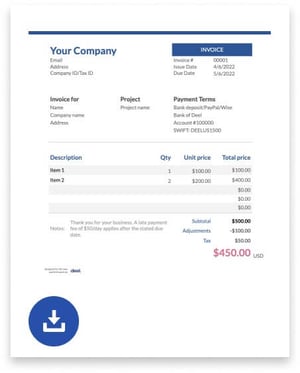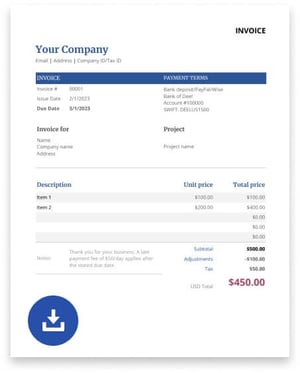
How to Invoice as an Independent Contractor [+ Template]

Key takeaways
- Begin your business relationship with a signed independent contractor agreement that outlines payment terms, including rates, schedules, and payment methods.
- Whether you charge by the hour or per project, keeping detailed records of your work hours and expenses is essential for efficient invoicing and makes tax season easier.
- To streamline your invoicing process and prevent late payments, consider automating your invoicing and payment request reminders. Automation can save you time and improve your cash flow by ensuring that clients receive timely reminders and invoices.
Step one: Refer to the independent contractor agreement for payment terms
Before creating an invoice, ensure that you and your client have created and signed an independent contractor agreement outlining your desired pay rate, schedule, and payment method. Some contractors prefer upfront payments, down payments, or payment upon a milestone/project completion, while others prefer hourly, weekly, biweekly, or monthly payments.
Once you have decided on the appropriate payment schedule, you can align your invoices accordingly.
On the Deel platform, contractors and clients can choose to generate compliant contracts, selecting the agreement type that best suits their business relationship and payment needs. This includes Fixed, Milestone, or Pay As You Go terms.
When a contractor signs a work contract on Deel, they can rest assured knowing that their contract will be compliant with their local laws, so they're ready to work from day one with clients across the globe. Data and intellectual property protection are also included.
See also: Flexible payment terms with Deel
Step two: Gather the necessary information
The next step in the invoicing process involves gathering all the necessary information regarding the services performed, the number of hours spent (if billing by the hour), and the subtotal of these services. Getting this information right requires effective time-tracking and record-keeping, which we’ll explain in more detail below.
Time-tracking
Time-tracking information is often necessary for calculating the price per service and populating your invoices. Whether you charge clients per hour, project, stage, unit, or by word, you’ll need to know your time spent to calculate your income for specific periods, improve efficiencies and design your service fees around the cost of living.
If you’re billing up-front or requesting a downpayment, you’ll need an archive of this information collected over time to bill accurately.
There are many free time-tracking tools and apps available, including:
- Clockify
- Toggl
- MyHours
- Harvest
The Deel platform seamlessly syncs with your favorite time-tracking and accounting tools to reduce manual tasks, eliminate data inconsistencies, and make life a lot easier.
Record-keeping
- Independent contractor agreements
- Business expenses and receipts
- Earnings
- Project records
- Tax returns
- Professional licenses and certifications
Google sheets and documents are also easier to share and edit than Microsoft Word and Excel documents that you need to download to your computer and resave every time you make an update. You can find generic invoice templates directly in Drive or download our free professional invoice templates below.
With Deel’s new bookkeeping tools, contractors can access a suite of features to help them manage their financial lives. The features include the following:
- Expense tracking: With the Expense Tracker, you can upload receipts, categorize work-related expenses, and assign them to specific clients to track reimbursements. This can save you hours on end-of-year bookkeeping, provide you with better visibility over your spending, and ensure you never miss an expense.
- Expert tax advice: Whether you’re looking for help with your own tax return or have a query about equity, our Tax Advice feature connects you with trusted local tax advisors who can explain your tax obligations and even file self-employment taxes for you with the relevant tax authority such as the IRS if you’re from the US).
- Tax summaries: This tool (coming soon) will help summarize your overall income and expenses across all invoices and expenses, making it easier to prepare for tax season. Simply hand these pre-prepared details off to a tax consultant.
Step three: Create the invoice
- Document name: Label the invoice document within the header using bold letters
- Company logo: If you have a company logo, include this in the header to add a touch of personalization and credibility
- Unique invoice number/ code: Assign dedicated numbers to each invoice to make record-keeping easier. Simple multi-digit numbers will do, or create a unique code system containing the invoice date and client name. This system is more complicated, but it can help you quickly find the exact invoice you need if there are many
- Invoice date: Include the sending date to prevent late payment and other miscalculations.
- Your business details: Business name, your name, and contact information (email, phone number, and maybe address)
- Client’s contact information: The same information as in the previous step, but include the billing contact or billing department of larger enterprises
- List of services: List each service you provided individually, along with a brief description of your work, amount of hours spent working (or word numbers, for writers), hourly rate (or price per word), and subtotal for each service
- Total amount due: Total cost for services listed above; you can add applicable tax and flat rate if needed
- Payment terms: State the payment method you accept (PayPal, Payoneer, bank account, crypto address, or something else). To learn more about payment options, check out our article on How to Get Paid as an Independent Contractor
- Payment due date: Include a specific payment deadline to avoid confusion that may occur if you write something vague, such as “15 days from the invoice reception date”
- Late payments policy: If you have such a policy, write down the details and what happens in case of late fees
Use our free invoice templates
Get a head start on your invoice design with one of our custom invoice templates. Easily edit these templates to reflect your brand and personality while obtaining all the necessary details to get paid on time.
Editable Google Sheets
invoice template

Use built-in formulas to quickly customize your invoice, all with the convenience of easy cloud access from your Google account.

Editable Google Docs
invoice template

Get a professional yet minimal template that's easy to edit and has plenty of room for payment information and billing comments.

Top tip: Add your repeating information (your contact information, business details, preferred payment methods, rules, and policies) to the template. Every time you send an invoice, make a copy of the template and add the remaining information according to each client, month, and task list. This approach will save you time and ensure you don’t copy over inaccurate information from an old client invoice.
Manage payments in seconds with automated invoices

Step four: Send invoice in a payment request email a week before the payment due date
If you explicitly outlined your payment terms in the independent contractor agreement at the start of the business relationship, your client will expect this email. You should send another reminder email on the day the payment is due.
If your client still hasn’t paid you a week after the due date, you should follow up with another payment reminder email. Make sure you remain polite and professional. There may have been some unforeseen complication, so make this more of a friendly reminder.
Finally, contact your client once weekly after the unpaid invoice’s due date if you still haven’t received payment. Most people resort to a phone call once they’ve sent a couple of reminder emails.
Bookkeeping systems like FreshBooks, QuickBooks, and ZipBooks can send automated payment reminders with the correct programming.
For more information on what to do in the case of late payment and to access our free payment request email templates, check out our article How to Professionally Ask for Payment From Clients.
Once you’ve generated a digital invoice on the Deel platform, it’s submitted to the client in real-time to help you avoid late invoices and ensure timely payment. It will appear pending until you receive a notification confirming it has been approved.
Use the Payment Tracker for an easy-to-follow timeline of when you can expect the payment to be processed.
Step five: Receive payment
Again, if you’ve outlined your payment terms in your contractor agreement, then you will have selected your preferred payment method.
For contractors residing in the same country as their clients, common and effective payment methods include direct deposit, paper checks, domestic wire transfers, and payment apps like PayPal.
However, when you're in a different country from your client, things get a bit more complex. You'll need to consider exchange rates, currency conversion fees, and various bank charges. These fees may apply to your client, yourself, or both. Some jurisdictions may require clients to pay contractors in the local currency, so it's essential to familiarize yourself with local labor laws to ensure that you receive compensation in compliance with these regulations.
Deel offers you the flexibility to choose how you want to receive payments based on your location, local payment regulations, and preferred withdrawal method. Although there are various options available for contractors to receive payments outside of the Deel platform, the on-platform options are more efficient and easier to use.
You can choose from 15 payment options, including:
- International bank transfers
- Local bank transfers
- Coinbase account transfer
- Binance
- PayPal
- Revolut
- Deel Card
- Deel instant card transfer
- Payoneer
With Deel, you and your client can choose how to process payments. That means the two of you can have different payment methods. For example, your client can pay with an international wire transfer, and you can choose how you want to withdraw and in which currency.
Deel always tries to optimize for a local payout, which minimizes the fees, making the payment process favorable for both parties.
Need early access to funds? Use Deel Advance to get paid up to 30 days earlier. Withdraw your advance by any of your withdrawal methods, or load it straight onto your Deel card.
Experience the benefits of getting paid through Deel
Automated invoicing, fast payments, low fees, and convenient perks like Deel Card and Deel Advance make our platform one of the most flexible and beneficial ways for contractors to avoid common contractor invoicing mistakes and get paid.
While there are many options to receive international payments in today’s fintech landscape, Deel is the all-in-one solution that ensures you can work from anywhere and with anyone, compliantly and securely.
The Deel platform has invoicing software integrations to automate your online invoicing and speed up the payment process. Every Deel invoice includes the name, address, company details, payment method, transaction details, and amount issued so that you remain professional and transparent. Deel also takes care of other documents, such as receipts and tax forms, which help you navigate compliance.
On top of that, with Deel, you and your client can choose how to process payments. That means the two of you can have different payment methods. For example, your client can pay with a wire transfer, and you can choose how you want to withdraw as soon as you have an available balance.
Sign up and unlock the smoothest contractor experience on the planet.



